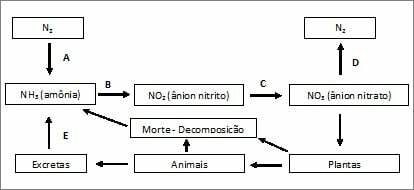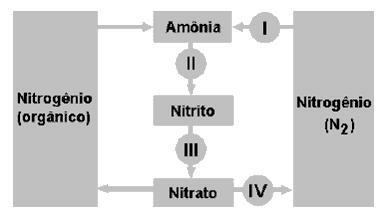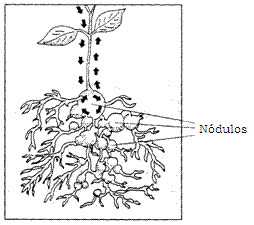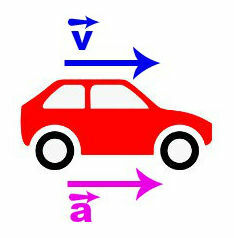O nitrogen cycle it is extremely important for living beings, however, they do not produce this element and need to acquire it through food.
This element is part of the composition of the amino acids, of the nucleic acids as DNA It is RNA, proteins and many other cellular structures.
see more
Biology teacher fired after class on XX and XY chromosomes;…
Cannabidiol found in common plant in Brazil brings new perspective…
We prepared a list of exercises on the nitrogen cycle so you can test your knowledge of this biogeochemical cycle.
You can consult the feedback and save this list of exercises in PDF at the end of the post!
Exercises on the Nitrogen Cycle
1) (UFRGS) Living beings maintain constant exchanges of matter with the environment through processes known as biogeochemical cycles.
Based on the biogeochemical cycles, mark with T (true) or F (false) the following statements.
( ) The atmosphere is the main reservoir of carbon, nitrogen, phosphorus and oxygen.
( ) In the water cycle, evaporation is less in the oceans, while precipitation is less on the land surface.
( ) Atmospheric nitrogen (N2) is incorporated into organic molecules through leaf absorption.
( ) All organic molecules of living beings have carbon atoms in their composition, and their return to the cycle can occur through decomposition processes.
The correct sequence for filling in the parentheses, from top to bottom, is:
a) T-F-T-T.
b) F-F-F-V.
c) V-T-F-F.
d) F-T-F-V.
e) T-F-T-F.
2) (UFG) During the spawning period of salmon in the Northern Hemisphere, 80 kg of nitrogen are released into the ecosystem derived from the capture of these fish by bears. This calculation was performed for a length of 250 meters of river. SCIENTIFIC AMERICAN, no. 52, 2006. Brazil. [Adapted].
According to the text, the decomposition of organic remains of salmon is an important factor for the nitrogen cycle in an ecosystem in the Northern Hemisphere. The absence of bacteria of the genus Nitrosomonas, can cause in this ecosystem:
a) Decreased availability of nitrate with consequent reduction in the uptake of this ion by plants.
b) Elevation of nitrite in the soil and consequent intoxication of microorganisms.
c) Increase in the nitrification process with a consequent increase in nitrite absorption by plants.
d) Fall of bacteria of the genus Rhizobium, decreasing symbiotic nitrogen fixation.
e) Reduction of ammonium ion and consequent decrease in chlorophyll synthesis.
3) (UDESC) Regarding the biogeochemical cycles, analyze the following statements:
i. In the carbon cycle: carbon chains form organic molecules through autotrophic beings through photosynthesis, in which carbon dioxide is absorbed, fixed and transformed into organic matter by producers. Carbon returns to the environment through carbon dioxide gas through respiration.
II. In the oxygen cycle: Oxygen gas is produced during the construction of organic molecules by respiration and consumed when these molecules are oxidized in photosynthesis.
III. In the water cycle: solar energy plays an important role, as it allows liquid water to evaporate. The water vapor, in the higher and colder layers, condenses and forms clouds that, later, precipitate in the form of rain, and the water from this rain returns to the soil forming rivers, lakes, oceans or even infiltrating the soil and forming the sheets phreatic.
IV. In the nitrogen cycle: one of the steps is nitrogen fixation, in which some bacteria use nitrogen atmosphere and make it react with oxygen to produce nitrite, which will be transformed into ammonia in the process of nitrification.
Tick the correct alternative.
a) Only statements II and IV are true.
b) Only statements I and II are true.
c) Only statements I, III and IV are true.
d) Only statements II, III and IV are true.
e) Only statements I and III are true.
4) (UFSC) The scheme below shows in a simplified way the nitrogen cycle in nature. The letters A, B, C, D and E indicate metabolic processes that occur in this cycle.

About this cycle, it is correct to state that:
01) The process shown in A is carried out only by symbiotic bacteria that live inside the roots of legumes.
02) The same bacteria that carry out process A, carry out processes D and E.
04) The scheme shows that nitrogenous products originating from animals or plants can be reused in the cycle.
08) The process shown in D constitutes a fundamental step in the cycle, called nitrogen fixation.
16) Plants can use ammonia directly and do not depend on the process that occurs in C to obtain nitrogenous products.
32) The process shown in E indicates that animals excrete ammonia.
64) Nitrogen is important for living beings, as it is part of the molecular composition of amino acids and nucleic acids.
5) (UDESC) Nitrogen atoms are part of the composition of proteins and nucleic acids. One can deliberately interfere with the Nitrogen Cycle in nature in order to increase the productivity of certain crops.
Mark the alternative that contains examples of plants usually used to increase the amount of nitrogen in the soil.
a) Strawberry – lettuce – onion.
b) Corn – potato – rice.
c) Cotton – potato – corn.
d) Soy – beans – peas.
e) Sesame – corn – chestnuts.
6) (UFV) The scheme refers to part of the nitrogen biogeochemical cycle. The numbers (I to IV) correspond to the stages that are involved in the dynamics of this cycle.

Check the alternative that contains two incorrect matches:
a) Fixation (I) and nitrification (II).
b) Denitrification (II) and fixation (IV).
c) Nitrification (II) and nitrification (III).
d) Denitrification (IV) and denitrification (III).
7) (UFMG) Look at this figure:

Nodules formed on legume roots result from colonization by nitrogen-fixing bacteria.
Due to the presence of these nodules in the roots, leguminous seeds – such as soybeans, for example – are good stores of:
a) starch.
b) carbohydrates.
c) lipids.
d) proteins.
8) (CEFET-PR) In agriculture, the crop rotation plan is widely used, where different plant species are successively cultivated in the same land. In this process, legumes are often cultivated, as these plants are associated with:
a) bacteria and enrich the soil with sulfur compounds.
b) bacteria and enrich the soil with nitrogenous compounds.
c) fungi and enrich the soil with nitrogenous compounds.
d) nematodes and enrich the soil with phosphorus compounds.
e) bacteria that make their roots fasciculate, attenuating the effect of erosion.
9) (ENEM) Nitrogen is essential for life and the largest global reservoir of this element, in the form of N2, is the atmosphere. The main responsible for its incorporation into organic matter are N2-fixing microorganisms, which occur freely or symbiotically with plants. ADUAN, R.E. et al. The great biogeochemical cycles of the planet. Planallina: Embrapa, 2004 [adapted].
Animals secure their metabolic needs for this element by:
a) absorption of nitrogen gas by breathing.
b) ingestion of vegetable carbohydrate molecules.
c) incorporation of dissolved nitrites in consumed water.
d) transfer of organic matter through the trophic chains.
e) proto-cooperation with nitrogen-fixing microorganisms.
10) (ENEM) Ethanol is considered a promising biofuel because, from the point of view of the carbon balance, it has an emission rate practically equal to zero. However, this is not the only biogeochemical cycle associated with ethanol production. The planting of sugarcane, raw material for ethanol production, involves the addition of macronutrients such as sulfur, nitrogen, phosphorus and potassium, the main elements involved in the growth of a vegetable. New Chemistry at School Magazine. on the 28th, 2008.
Nitrogen incorporated into the soil, as a result of the activity described above, is transformed into active nitrogen and will affect the environment, causing:
a) the accumulation of insoluble salts, triggering a soil salinification process.
b) the elimination of existing microorganisms in the soil responsible for the denitrification process.
c) the contamination of rivers and lakes due to the high solubility of ions such as NO3– and NH4+ in water.
d) the decrease in soil pH due to the presence of NH3, which reacts with water to form NH4OH(aq).
e) the decrease in soil oxygenation, since active nitrogen forms NO-type chemical species2, AT THE3–, No2
feedback
1 — b
2 — the
3 — and
4 — 04 and 64
5 — d
6 — b
7 — d
8 — b
9 — d
10 — c
Click here to save this list of exercises in PDF!
- List of Exercises – Kingdom Animalia
- List of exercises on food chains
- List of exercises on intraspecific ecological relationships

